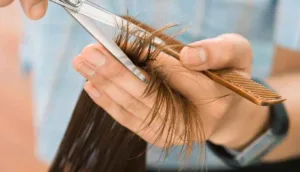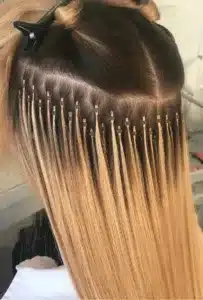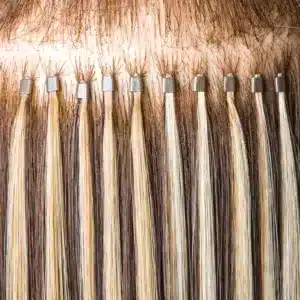Clients ask for hair that looks real and feels light. Poor method choice leads to visible seams, scalp tension, and early removals. Match the weft to the head. Plan weight. Protect the scalp.
Hand tied hair extensions pros and cons are clear. Pros: ultra-flat seam, light feel,very invisible, clean blends on fine hair, strong client retention. Cons: higher cost, no cutting at the seam, delicate stitching, strict 6–8 week move-ups, risk of traction if overweighted.
Hand tied rows can be the most invisible option in the salon. They also demand the most discipline. This guide breaks down structure, real advantages, real drawbacks, safety, install workflow, aftercare, and when to choose genius or machine wefts instead.
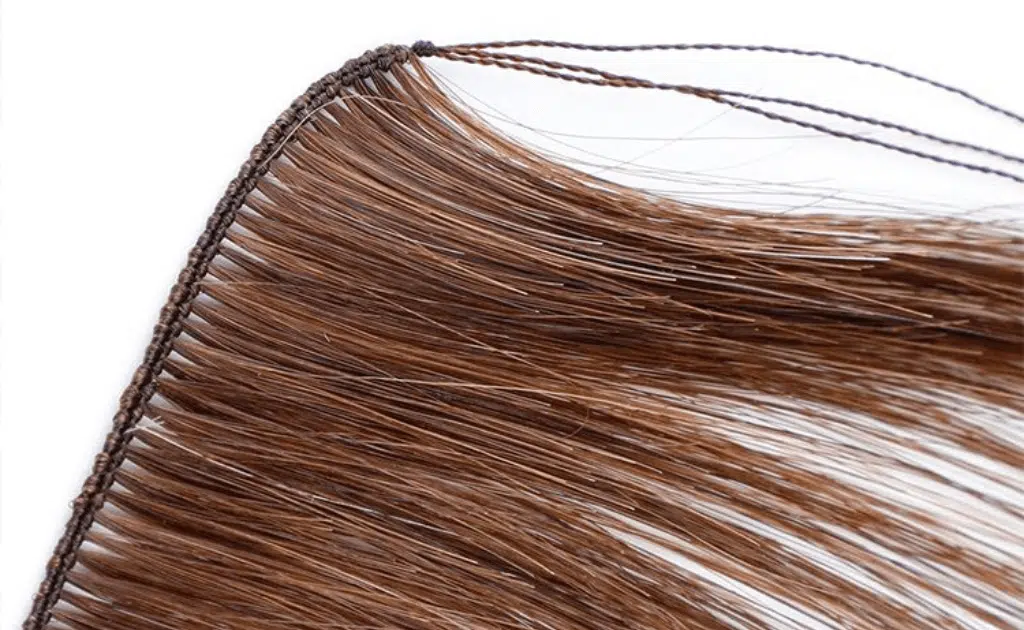
What are Hand Tied Hair Extensions?
Clients want invisible seams and comfort. Many methods add bulk. A hand-tied seam solves that bulk and sits flat under fine hair.
Hand tied hair extensions are wefts stitched by hand into a very thin seam. The seam flexes, lies flat, and stacks cleanly in rows. The seam must not be cut, or it unravels. The method suits fine-to-medium density when weight is planned well.

Construction and anatomy
A hand tied weft is built from micro bundles of hair knotted and stitched along a soft tape-like spine. Typical seam height is ~1–2 mm, which is far thinner than standard machine wefts. The small knots create a flexible hinge, so the row conforms to head shape and moves with the scalp during sleep and exercise. Because the seam is hand-stitched, cutting across it will loosen knots and cause shedding from the edge; only folding or pre-sized pieces preserve integrity.
Raw hair options for hand tied performance
Hand tied results depend on the fiber.
Choose full cuticle, single-donor hair for rows that re-install cleanly over multiple cycles. It keeps the hand-tied seam light without needing high grams to hide fiber fatigue.
Hand tied vs seam alternatives
Genius weft uses a micro-sealed seam that you can cut anywhere, which speeds mapping and custom widths. Machine weft uses a stitched and glued band that is thicker but durable and cost-effective for high-gram installs. Hand tied remains the flattest at the seam and the most forgiving under fine hair in wind, parts, and high ponytails.
What are the advantages of Hand Tied Hair Extensions?
Some methods blend well but feel heavy. Others feel light but print through. Hand tied seeks the middle: invisible and wearable.
Advantages include the flattest seam, lighter head feel, better blend with fewer grams, and strong retention when move-ups stay on schedule. These benefits support premium pricing and repeat bookings.

Seam invisibility and blend control
The 1–2 mm seam stacks tightly, so stylists can layer two to four micro-panels per row without creating a ridge. This helps hide under fine hair and permits higher placement near the parietal area without “printing.” The result is a clean hairline in wind, better updos, and less beveling.
Lightweight wear and client comfort
Thin seams spread mass closer to scalp curvature. This lowers leverage on anchors and reduces the “helmet” sensation. Clients report better sleep comfort and fewer pressure points during long wear. Gym and headset users notice less rubbing at the band.
Efficiency with grams
Because seams are thin, you can build density in smaller increments. Many heads reach target fullness with 100–160 g instead of 180–220 g. Lower grams mean faster dry time, reduced heat exposure, and less torque at the anchors.
Business impact
The craft, the look, and the comfort justify premium tickets. A predictable 6–8 week move-up cadence stabilizes the book and drives retail aftercare. Clients who value invisible seams become long-term row clients.
| Advantage | For the client | For the salon |
|---|---|---|
| Ultra-flat seam | Natural look in any part | Fewer visibility reworks |
| Flexible row | Softer wear, better sleep | Fewer comfort complaints |
| Lower grams | Faster styling, less heat | Lower risk at anchors |
| Premium craft | Confidence in public | Higher ticket + rebook rhythm |
What are the disadvantages of Hand Tied Hair Extensions?
Every method has limits. Ignoring these limits creates slips, fray, and scalp stress. Hand tied is no exception.
Disadvantages: you cannot cut the seam; seams are delicate; the method costs more and takes longer; mapping and weight mistakes raise traction risk; overdue move-ups cause matting at the base.
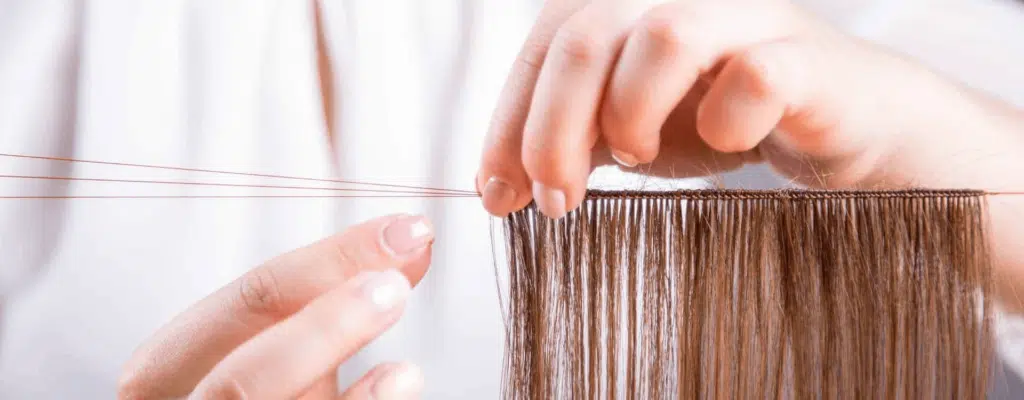
No cutting at the seam
You cannot trim width along the stitch line. If you cut, knots unravel and hair sheds from the edge. You must fold or use pre-sized pieces. This takes planning and may add time. Genius wefts are the better choice when micro-widths are essential.
Higher material and labor cost
Hand stitching raises unit cost. Installation includes building a beaded track, stacking multiple micro-panels, and edge-lock stitching. Expect longer chair time than tapes or machine wefts. Ticket prices must reflect both hair quality and labor.
Delicate seam care
Aggressive brushing near the seam or beads placed too close to the stitch line can fray the edge. Educate clients to brush from ends upward with an extension brush and to avoid yanking at the base. In the back room, keep tools smooth and replace dull needles that snag thread.
Tension risk if overweighted or overdue
Any row system can pull if grams are high relative to natural density, if tracks are tight, or if move-ups are late. Respect gram limits by density tier and set firm 6–8 week move-up rules.
| Drawback | Practical risk | Mitigation |
|---|---|---|
| No seam cutting | Unravel/shedding | Use folds; order correct widths; consider genius |
| Cost/time | Budget pushback | Tiered options; show value photos; clear menu |
| Seam fragility | Fray/snags | Brush training; bead distance; edge-locking |
| Overweighting | Traction stress | Gram caps by density; timely move-ups |
Are hand tied extensions bad for your hair?
Clients worry about damage. The truth depends on planning, weight, cadence, and aftercare.
Hand tied extensions are not bad for hair when weight matches density, rows avoid tension zones, and move-ups happen every 6–8 weeks. Problems arise from heavy builds, tight anchors, oil saturation at the base, and overdue maintenance.
Risk model
Traction alopecia risk relates to force at the follicle over time. Force increases with grams, lever length, anchor tightness, and torque from high ponytails. Risk also rises with sweat/salt build-up and sunscreen migration that soften thread and create slippage, which adds rubbing.
Safe weight and row planning
Use fewer rows with lighter stacks. Keep beads off the seam. Position tracks along stable zones that follow head shape. Maintain clean spacing to allow scalp hygiene.
| Natural density | Typical rows | Gram range | Notes |
|---|---|---|---|
| Fine | 1–2 | 60–120 g | Focus on invisibility; keep ponytail low |
| Medium | 2 | 100–160 g | Most common plan |
| Thick | 2–3 | 140–200 g | Consider mixing genius/machine low |
Maintenance cadence and hygiene
Book move-ups at 6–8 weeks. At each visit, remove rows, clear shed, cleanse, and rebuild the track. Late move-ups trap shed hair and increase matting that looks like “webbing.” Teach clients to dry roots fully after washing and to sleep in a loose braid.
How are hand tied installs done, and when are move-ups due?
A clean install starts with mapping and ends with education. The move-up timeline protects both hair and business.
Install usually takes 1.5–3 hours for 1–3 rows. Move-ups are due every 6–8 weeks. Use a beaded track, stitch stacked hand-tied panels, secure edges, blend, and teach care.
Tools and prep
Prepare a sectioning comb, silicone-lined micro beads, pulling tools, extension thread, curved needle, clean clips, and an extension brush. Start with clean, dry hair. Clarify if needed. Photograph the head and mark mapping lines that avoid crown tension points.
Track, stitch, secure
Build an even beaded track along the marked line. Keep consistent spacing and avoid over-tightening beads. Lay hand-tied panels and stack to target density. Stitch with blanket or hidden stitch, locking corners with micro-lock knots placed off the skin. Test comfort after each row.
Blend and finish
Point-cut or bevel ends lightly to match natural density. Do not remove paid length without consent. Style, then photograph result under even light for records.
Timing and QC
Use a time plan and a quality checklist at each visit.
| Step | Time guide | Quality checks |
|---|---|---|
| Mapping + photos | 15–20 min | Lines follow head shape; document density |
| Beaded track | 15–30 min/row | Even spacing; no pinch pain |
| Stitching | 20–30 min/row | Edge locks; no seam stress |
| Blend/finish | 15–25 min | Perimeter seamless; natural movement |
| Education + booking | 5–10 min | Care rules understood; next visit set |
Hand Tied vs Genius vs Machine: which should you choose?
Not every head needs hand tied. Choose based on density, goals, budget, and maintenance behavior.
Pick hand tied for ultra-flat seams on fine–medium density. Pick genius for custom widths and speed. Pick machine for high grams and value.
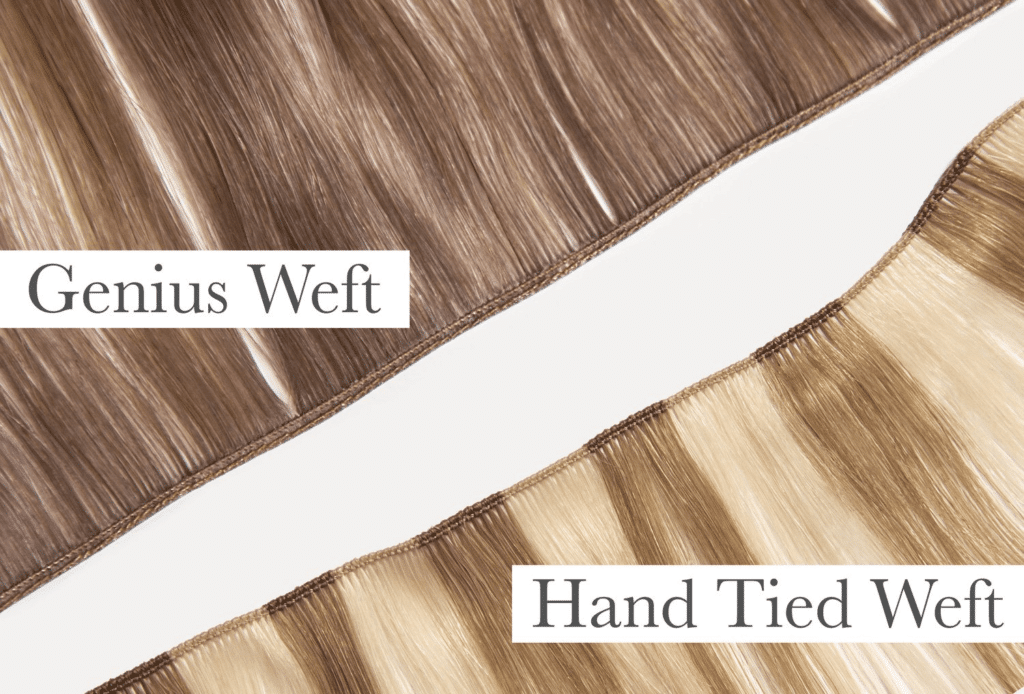
Match to goals
If the primary goal is invisibility and scalp comfort, hand tied leads. If micro-widths and quick mapping matter, genius wins. If maximum fullness at lower cost is the goal, machine wefts deliver.
Comparative summary
| Criteria | Hand tied | Genius weft | Machine weft |
|---|---|---|---|
| Seam profile | Ultra-flat, soft | Thin, sealed | Thicker, rigid |
| Cut at seam | No | Yes | Yes |
| Ideal density | Fine–medium | Any (custom widths) | Medium–thick |
| Speed | Moderate | Fast | Fast |
| Cost | Highest | High–mid | Mid–low |
| Best use | Invisible rows | Precision mapping | High-gram volume |
Hybrid plans
Many installs mix types: hand tied on the top row for invisibility, genius in the middle for cut-to-fit widths, machine low for mass. Record the mix for consistent move-ups.
Aftercare, product rules, and warranty
A great install fails without simple rules the client will follow at home.
Clients should brush from ends up, dry roots fully, sleep in a loose braid, use sulfate-free cleansers, keep oils mid-length to ends, and avoid sunscreen migration onto hair. Move-ups at 6–8 weeks are part of the warranty.
Product do’s and don’ts
Use gentle, sulfate-free shampoos. Condition mid-lengths to ends, not the base. Apply heat protectant before hot tools. Avoid heavy oils and silicone serums at the seam. Be alert to sunscreen actives like avobenzone/octocrylene on neck and shoulders; they can discolor light blond tones and soften stitches.
Water, sweat, and sleep
After swimming, rinse with fresh water, then cleanse and condition. Dry roots fully to prevent mildew odor and slip. Sweat salts add friction; rinse after workouts. Sleep on silk or satin and secure hair in a loose braid or low pony.
Service policy and records
Tie warranty to on-time move-ups, approved products, and proper brushing. Photograph at each visit. Note grams, row placement, and any scalp feedback. This protects both client and salon.
| Care area | Rule | Why it matters |
|---|---|---|
| Brushing | Ends to roots with extension brush | Prevents seam stress |
| Drying | Dry base completely | Stops slip and mildew |
| Products | Sulfate-free, light mid-to-ends | Preserves stitching and tone |
| Schedule | 6–8 week move-ups | Clears shed, resets tension |

My opinion
From a manufacturing view, the cleanest results come from full cuticle, single-donor hair paired with light, well-mapped hand tied rows. Keep grams modest. Respect the no-cut seam. Offer genius or machine alternatives when custom widths or high grams are required. This protects the scalp, preserves the row, and keeps re-installs predictable for the salon and for the client.
FAQ
Q1. What are the primary hand tied hair extensions pros and cons?
Pros: ultra-flat seam, soft wear, great blends with fewer grams, premium client experience. Cons: higher cost, no cutting at seam, delicate stitching, strict 6–8 week move-ups.
Q2. Are hand tied extensions bad for your hair?
Not when weight and placement match density and move-ups stay on time. Issues come from heavy builds, tight anchors, and overdue maintenance.
Q3. How many rows and grams are typical?
Most clients wear two rows, 100–160 g total. One row for volume-only. Three rows for long lengths or dense natural hair with careful mapping.
Q4. Can hand tied wefts be cut to width?
No. Cutting across the hand stitch unravels the seam. Use folds or pre-sized pieces. Choose genius wefts when cutting is essential.
Q5. How long do hand tied installs take and how often are move-ups?
Initial install: 1.5–3 hours for 1–3 rows. Move-ups: every 6–8 weeks, taking 1–2 hours.
Q6. Which clients are ideal candidates?
Fine–medium density who want invisible seams and can maintain the 6–8 week cadence. Very dense hair or budget-sensitive clients may prefer machine or genius wefts.
Q7. Do hand tied extensions work for curly textures?
Yes. Use matching curl patterns, plan extra grams for full ends, and map rows to the curl’s dry shape. Diffuse dry the base completely.
Q8. What causes fray at the seam?
Aggressive brushing at the stitch, beads placed too close to the seam, or snagging tools. Mitigate with bead spacing, edge-lock stitches, and client brush training.
Q9. How do hand tied rows compare to tape-ins?
Rows rely on stitching and bead tracks, not adhesive. They sit flatter than machine wefts but take longer than tapes. Tapes are quick but add adhesive maintenance and printing risk in very fine hair.
Q10. What aftercare products are safest?
Sulfate-free shampoo, lightweight conditioner on mid-to-ends, leave-in detangler, thermal protectant. Avoid heavy oils at the seam and watch sunscreens that contain avobenzone/octocrylene around light blond hair.
Q11. Can clients wear high ponytails and buns?
Yes, in moderation. Keep tension low and rotate styles. Daily high, tight ponytails increase torque and shorten install life.
Q12. What signals an overdue move-up?
Matting at the base, bead imprinting, scalp soreness, and increased shedding trapped in the row. Book sooner and reset the track.
Conclusion
Hand tied rows excel at invisibility and comfort but demand precise mapping, lighter grams, and on-time move-ups. Choose method by density, goals, and maintenance discipline.
where to buy hadntied weft hair extensions
Hibiscus Hair Manufacturer has been dedicated to producing high-quality hair extensions for 25 years and is a recognized leader in the industry. If you are interested in finding a reliable hair extensions supplier and wholesale for your brand, please visit our website for more information:
Hand tied Weft Hair Extensions

